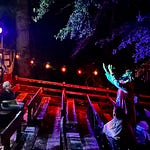At the last supper, when Judas had gone out, Jesus said, "Now the Son of Man has been glorified, and God has been glorified in him. If God has been glorified in him, God will also glorify him in himself and will glorify him at once. Little children, I am with you only a little longer. You will look for me; and as I said to the Jews so now I say to you, 'Where I am going, you cannot come.' I give you a new commandment, that you love one another. Just as I have loved you, you also should love one another. By this everyone will know that you are my disciples, if you have love for one another." John 13:31-35
All right, class. Quiz time. When did we last encounter this morning’s Gospel text?
That’s right. We last encountered today’s Gospel lesson on Maundy Thursday. Right around a month ago. In case you’re wondering why we are circling back to this story again, it may be because the people responsible for putting the lectionary together – and maybe the Holy Spirit – think we need to bone-up on the lesson. As it happens, my sermon today is also a class assignment in New Testament while I’m wrapping up my first year in seminary. So I’m going to don my best teacher robes and begin the lecture. Feel free to take notes. No cell phones, please.
Throughout John’s Gospel, Jesus appears as a kind of Moses figure leading his followers out of the wilderness on the way to a new kind of Promised Land.1 Jesus was the new Moses: liberator, law giver, leader of a new thing. As the Israelites had a wilderness to negotiate, we can think of Jesus’s wilderness as where John the Baptist lives and where the Jewish people lived at this time – an in-between place where the Empire has moved in and nothing is really and truly theirs. Where everyone is on edge.
Jesus’s ministry to this point echoes Moses in striking ways. Moses had to reckon with Pharaoh; Jesus with the Romans. Moses had a beloved brother, Aaron, who carried his message; Jesus has the Beloved Disciple.2 Moses meets a fiery burning bush where God calls Godself “I AM”; Jesus, throughout the Gospel, repeatedly refers to himself in “I AM” terms.3 I am the way. I am the vine. I am the door. I am the bread of life. I am the good shepherd. Moses has twelve tribes; Jesus has twelve disciples. In another Moses story, he puts a serpent up on a pole as a sign of healing and mercy. Soon, it’ll be Jesus up on the pole. Moses has manna sent down from heaven to sustain God’s people. Jesus is that manna. You still with me?
And that’s what today’s Gospel passage is about: that Jesus is a lot like Moses. If you’d like some extra credit this week, consider bringing back this part of John and laying it alongside Exodus 24. In that story, Moses and leaders of the twelve tribes go up on a mountain – a lofty place, like Jesus’s Upper Room – and they meet God.4 God gives Moses the commandments. There’s a sacrifice – body and blood. There’s a meal. Jesus is doing the same thing here, but in his own new way.
Both Moses and Jesus are teachers with lessons they’ve learned from God. Commandments. And we see them over and over again passing things down, like dishes at a common meal. Like advice. Like a last will and testament. Like knowledge from some wise professor of faith.
Today, we’re being passed down to. Here we are, at the table together, trying to meet God and Moses and Jesus and wondering what lessons they have for us.
In this way, we are like what scholars call the “Johannine Community,” which is a branch of the Jesus movement in the first century who have some responsibility for the text before us. Scholars differ—some say the story passed from teacher to teacher, others that the whole community shaped it. However that worked, most scholars agree that the Gospel reflects the experiences of Christians in a specific time and place a few generations after the events of Jesus’s life.5 Just like us.
And this community was having a tough time. They were troubled. We might call it a social crisis. An identity crisis. Perhaps these early Christians had been expelled from the synagogue.6 They might have been on the wrong end of a turf war with another branch of the Jesus movement. They were subject to some significant level of persecution by the Romans. Their world was crumbling. And we can imagine them gathering around tables and burning fires like Moses and Jesus had before them, wondering about the lessons they were to learn:
What it meant to be uncertain that they had this Jesus stuff right.
What it meant to be failing at it, perhaps like Peter and the other disciples.
What it meant to experience betrayal and abandonment, like when Judas leaves the table a few verses before our reading today.
What it meant to lose hope.
In the way we find ourselves with roles in the story of this morning’s text, we also find ourselves with roles in the story of how this text came to be, and what it has meant to earlier generations of Christians.
Here we are, gathered around a table. There’s bread and wine. A sacrifice. A meal. And it’s worth noticing what Jesus does in this story. Just prior to today’s reading, Jesus washes the feet of the students in front of him.7 He breaks bread and gives it even to a student who storms out.8 And he offers the rest a final lesson. Right here, surrounded by students who have become friends and who cannot join him when he ascends the mountain in a day or so. Who do not get it. Not yet.
And he offers a New Commandment, chiseling it like Moses into the hearts of those who will keep it:
Love one another, just as I have loved you.
This New Commandment we might think of as the point of an inverted triangle. Moses had ten commandments. The Gospel of Mark has two. Here, the Gospel of John has just the one. Each of these commandments is about how we live together with God and each other. John’s is simple and powerful. Not different from what we’ve heard before, but perhaps a bit more distilled. This is how we live together.
Most scholars suggest that many of Jesus’s disciples were likely younger than we tend to imagine, and not just because Jesus calls them “little children” in today’s passage.9 In Greek, the word also connotes the idea of offspring. Jesus is the teacher; the disciples are the learners. And in the context of the ancient world, Jesus the rabbi-teacher would have been in his late twenties or early thirties, and his disciples would have been mostly teenagers and perhaps a few twentysomethings.
That idea changes how I experience this story for me. As a person who has taught teenagers and twentysomethings for the last 18 years and who has two teenagers at home, especially at the end of the school year, I’ve seen young people panic – storming out of the room, calling the department chair, discovering they are failing. The teacher in me has to think carefully about what to say in these moments, but I’ve found it sometimes helpful to tell them that this is where learning happens. When it’s hard. When we’re broken. That’s where the good stuff of life is. Failures are where you find yourself. A glorious mess where love is happening even when everything seems to be going wrong.
Teachers have a habit of producing students who will show up down the road doing just fine despite some earlier struggles. And Jesus is a good teacher. Moses was, too, for all we who think of ourselves as the children — the students — of Israel.
Some of you know I’ve been working as a student intern at a local transitional housing shelter for men these last few months. At the shelter are folks who’ve struggled to find a place they can belong out in the world, and they’re here, having had to give up other parts of their lives for one reason or another, maybe a bit like the disciples. They’re sometimes on the ropes. Sometimes at the ends of those ropes. Things have gone wrong—both on account of their own personal failures and our community’s failures of them. A number of them sometimes feel trapped at a younger age. A time when something in their lives went awry and they just sorta got stuck.
My time with these men is coming to an end. And so I took an opportunity this week to ask them, “Okay, guys, what would you want to impart if this was your last week on earth? Who would you want to see? What would you want to say?”
It will surprise no one that they want one more chance to show the children in their lives how much they love them. To simplify everything they’ve ever learned and want to pass down to something simple. Here, at the ends of the rope, we see what love looks like. A parting class. A good lesson. We arrive in the Promised Land when we learn how to love the people who are in it.
Note: The text and audio above is from a sermon delivered at Holy Trinity Episcopal Church in Fayetteville, North Carolina, based on readings for the Fifth Sunday of Easter, Year C.
Martin, Carl T. “The Identification of New Exodus Themes in John 13–17.” Tyndale Bulletin 72 (December 31, 2021): 97–99. https://doi.org/10.53751/001c.31749.
Ibid.
Mary Edith Andrews, “The Authorship and Significance of the Gospel of John,” Journal of Biblical Literature 64, no. 2 (1945): 183–192.
Seung-In Song, “Seeing the Johannine Last Meal as a Covenant Meal (John 13 and Exodus 24),” Biblica 100, no. 2 (2019): 282–292.
Adela Yarbro Collins, “Crisis and Community in the Gospel of John,” Currents in Theology and Mission 7, no. 4 (1980): 196–204.
Ibid.
Francis J. Moloney, “The Literary Unity of John 13,1-38,” Ephemerides Theologicae Lovanienses 91, no. 1 (2015): 33–53.
Keith L. Yoder, “Gathered into One: Mary and Judas in John 11–13,” Novum Testamentum 63, no. 3 (2021): 323–345.
Mark Jennings, “The Fourth Gospel’s Reversal of Mark in John 13,31-14,3,” Biblica 94, no. 2 (2013): 210–236.








